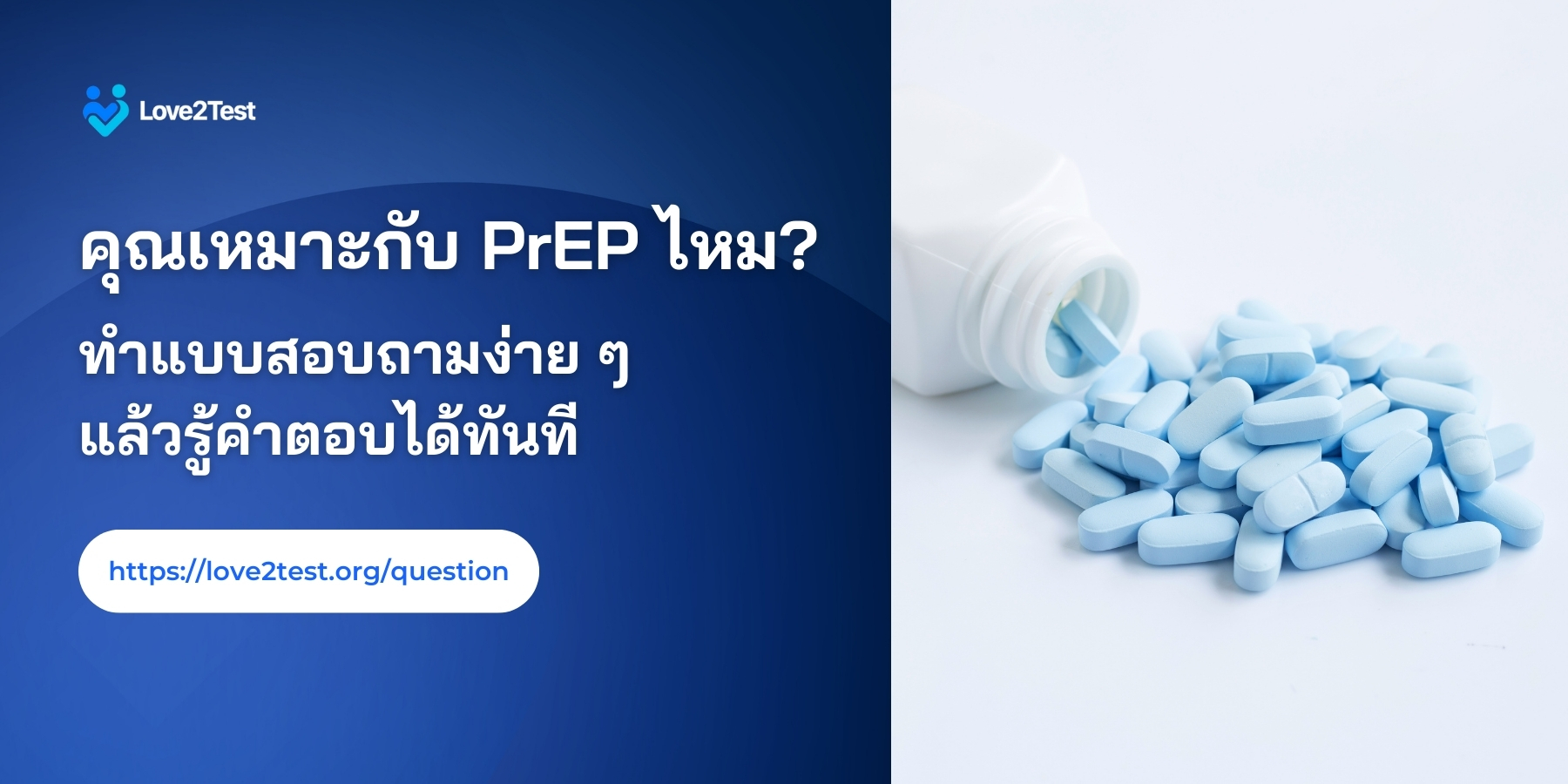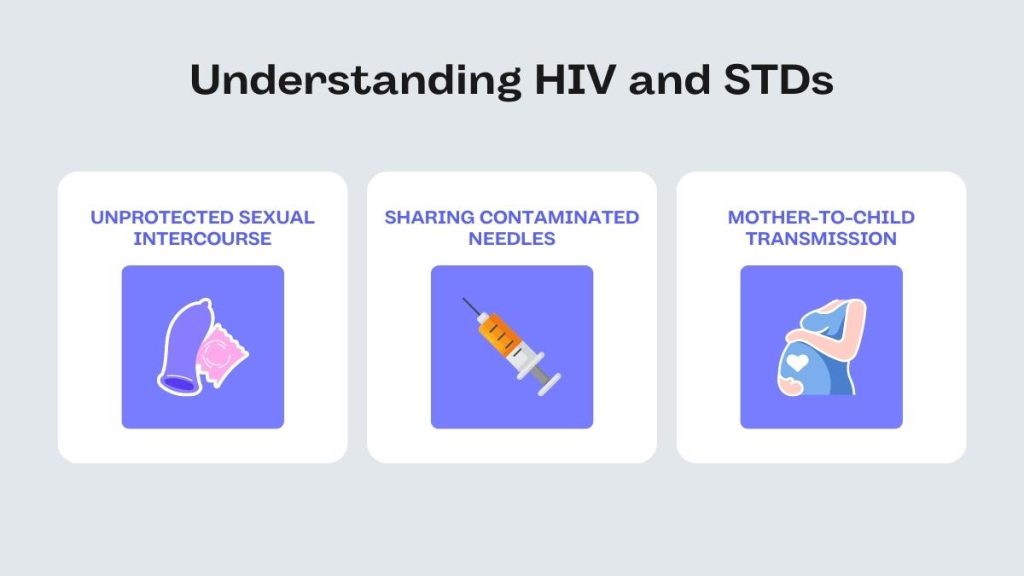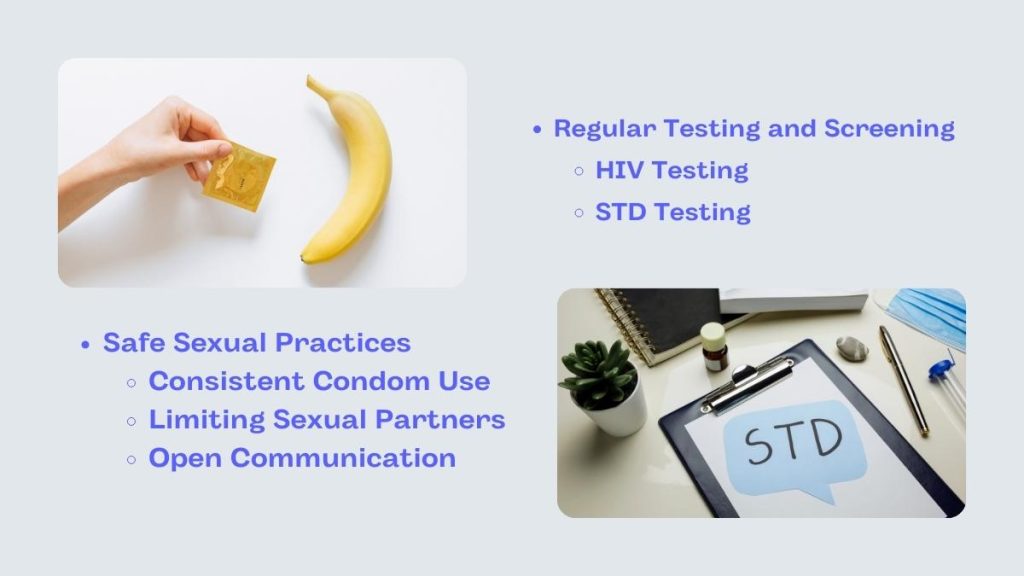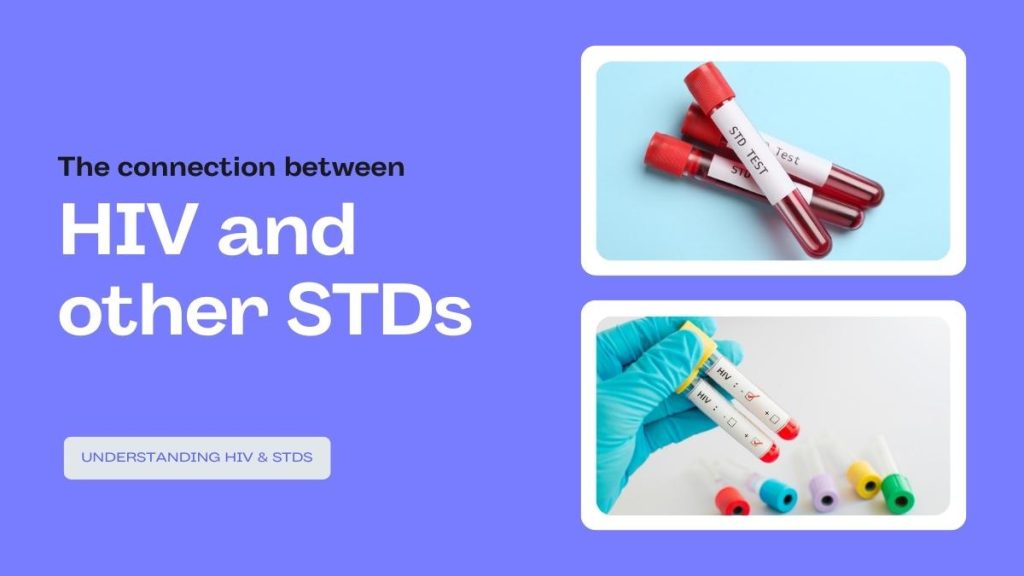HIV, or Human Immunodeficiency Virus, is a viral infection that weakens the immune system, making individuals more susceptible to other infections, including sexually transmitted diseases (STDs). There is a strong interconnection between HIV and other STDs due to shared risk factors and transmission routes. Engaging in unprotected sexual activity, such as unprotected vaginal, anal, or oral sex, increases the chances of acquiring both HIV and other STDs. Additionally, certain STDs, like syphilis, herpes, and gonorrhea, can facilitate the transmission of HIV by causing genital sores or inflammation that make it easier for the virus to enter the bloodstream. Conversely, individuals with HIV are at higher risk of contracting other STDs due to their weakened immune systems. Therefore, addressing the prevention, testing, and treatment of both HIV and other STDs is crucial for overall sexual health and reducing the spread of these infections.
List of contents
1. Importance of STD Education & Prevention in Maintaining Good Health
2.The Link between HIV and Other STDs

- 2.1 Shared Modes of Transmission
- 2.2 Biological Factors
- 2.3 Behavioral Factors
- 2.4 Impact on HIV Transmission
- 2.5 Testing and Prevention
3. Specific STDs and their Relationship with HIV
Understanding HIV and STDs
HIV (Human Immunodeficiency Virus) and STDs (Sexually Transmitted Diseases) are two different but interconnected topics. Let’s understand them separately:
HIV
HIV is a virus that attacks the immune system, specifically the CD4 cells (T cells) that help the body fight off infections. If left untreated, HIV can lead to a condition called AIDS (Acquired Immunodeficiency Syndrome), where the immune system becomes severely weakened, making the person susceptible to various infections and diseases.HIV is primarily transmitted through specific bodily fluids, such as blood, semen, vaginal fluids, and breast milk. The most common modes of transmission include:

- Unprotected sexual intercourse (vaginal, anal, or oral) with an infected partner.
- Sharing contaminated needles, syringes, or other drug paraphernalia.
- Mother-to-child transmission during childbirth or breastfeeding.
It’s important to note that HIV is not transmitted through casual contact, such as hugging, kissing, sharing utensils, or mosquito bites.While there is currently no cure for HIV, it can be managed effectively with antiretroviral therapy (ART). ART can suppress the virus and allow individuals living with HIV to lead long and healthy lives. Prevention methods like practicing safe sex, using condoms, and avoiding sharing needles are crucial in reducing the risk of HIV transmission.

STDs
STDs, also known as STIs (Sexually Transmitted Infections), refer to a group of infections that are primarily transmitted through sexual contact. There are various types of STDs caused by different bacteria, viruses, or parasites. Some common examples include:
- Chlamydia
- Gonorrhea
- Syphilis
- Herpes (HSV-1 and HSV-2)
- Human papillomavirus (HPV)
- Trichomoniasis
STDs can be transmitted through vaginal, anal, or oral sex, as well as through sharing contaminated needles or coming into contact with infected blood or bodily fluids. In some cases, STDs can also be transmitted from mother to child during childbirth.
The symptoms of STDs can vary depending on the specific infection. Some STDs may not present any visible symptoms, making regular testing important for early detection and treatment. If left untreated, STDs can lead to complications such as infertility, chronic pain, and an increased risk of HIV transmission.
Prevention methods for STDs include practicing safe sex by using condoms, getting vaccinated (e.g., HPV vaccine), regular testing, and limiting the number of sexual partners. Treatment for STDs typically involves medication, such as antibiotics or antiviral drugs, depending on the specific infection.
The Link between HIV and Other STDs
There is a significant link between HIV and other STDs (Sexually Transmitted Diseases). Several factors contribute to this connection:
HIV and many other STDs share similar modes of transmission, primarily through sexual contact. Unprotected sexual intercourse (vaginal, anal, or oral) with an infected partner is a common route for both HIV and many STDs. The presence of other STDs can increase the risk of HIV transmission during sexual activity. STDs can cause genital ulcers, inflammation, and other disruptions in the mucous membranes, making it easier for HIV to enter the body.
Biological Factors
Some STDs can increase an individual’s susceptibility to HIV infection. For example, STDs like syphilis, genital herpes, and chlamydia can cause sores, lesions, or inflammation, which can serve as entry points for the HIV virus. These infections can also lead to an increase in HIV viral load in the genital fluids, making transmission more likely.
Behavioral Factors
Engaging in risky sexual behaviors, such as having multiple sexual partners, inconsistent condom use, or using drugs and alcohol that impair judgment, can increase the likelihood of both acquiring and transmitting HIV and other STDs. High-risk sexual behaviors that lead to the transmission of one infection may also contribute to the transmission of others.
Impact on HIV Transmission
Having another STD can significantly increase the risk of HIV transmission. For example, studies have shown that individuals with herpes simplex virus type 2 (HSV-2) infection are at higher risk of acquiring and transmitting HIV. The presence of other STDs can cause inflammation, immune activation, and recruitment of HIV target cells, facilitating the transmission of the virus.
Testing and Prevention
The link between HIV and other STDs highlights the importance of regular testing for both infections. Routine STD screening and HIV testing can help identify infections early, facilitate timely treatment, and prevent further transmission. Treating and managing other STDs can also help reduce the risk of HIV transmission.
Specific STDs and their Relationship with HIV
Here are a few specific STDs and their relationship with HIV:
Genital Herpes (HSV-2)
Genital herpes is a common sexually transmitted infection caused by the herpes simplex virus type 2 (HSV-2). Individuals with genital herpes are at a higher risk of acquiring and transmitting HIV. The presence of genital herpes lesions can cause breaks in the skin, providing an entry point for the HIV virus. Additionally, herpes infection can lead to an increase in HIV viral shedding, increasing the risk of HIV transmission to sexual partners.
Syphilis
Syphilis is a bacterial infection caused by the bacterium Treponema pallidum. Syphilis and HIV have a bidirectional relationship. Syphilis can increase the risk of acquiring HIV as the presence of syphilis sores (chancre) can provide an entry point for HIV. Conversely, individuals with HIV are more susceptible to acquiring syphilis if exposed. Co-infection with syphilis and HIV can lead to more rapid progression of both infections if left untreated.
Gonorrhea
Gonorrhea is a bacterial infection caused by Neisseria gonorrhoeae. The presence of gonorrhea can increase the risk of HIV transmission. In individuals with gonorrhea, the inflammatory response and damaged mucous membranes can provide an easier pathway for HIV to enter the body. Similarly, HIV infection can make individuals more susceptible to acquiring gonorrhea if exposed.
Chlamydia
Chlamydia is a bacterial infection caused by the bacterium Chlamydia trachomatis. Like gonorrhea, chlamydia can increase the risk of HIV transmission. The inflammation caused by chlamydia can lead to an increased concentration of HIV target cells, making it easier for HIV to establish an infection. HIV-infected individuals are also at a higher risk of acquiring chlamydia if exposed.
Human Papillomavirus (HPV)
HPV is a viral infection with various strains that can cause genital warts and is linked to cervical, anal, and other cancers. While HPV infection itself does not directly increase the risk of HIV transmission, individuals with HPV-related lesions or ulcers may be at a higher risk of HIV acquisition. Additionally, co-infection with HIV can lead to more severe HPV-related diseases.
Impact on HIV Prevention and Treatment
The impact of other STDs on HIV prevention and treatment is significant. Here are some key points regarding their impact:
Prevention:
- Risk Amplification: Having another STD can amplify the risk of HIV transmission. STDs such as genital herpes, syphilis, gonorrhea, and chlamydia can cause genital sores, ulcers, or inflammation, which create entry points for HIV. This increases the likelihood of HIV transmission during sexual activity.
- Behavior Influence: STDs can influence sexual behaviors that contribute to HIV transmission. For example, individuals with an STD may engage in risky sexual behaviors, such as inconsistent condom use or having multiple sexual partners, which can increase the chances of acquiring or transmitting HIV.
- Coinfection: Having an STD can facilitate the transmission of HIV by increasing viral shedding or HIV concentration in genital fluids. It can also heighten susceptibility to HIV infection if exposed.
Testing and Diagnosis:
- Increased Detection: Routine STD testing can lead to the early detection of both STDs and HIV. Integrated testing programs can identify individuals with HIV and other STDs simultaneously, enabling prompt diagnosis and timely initiation of treatment.
- Shared Testing Strategies: Many healthcare settings offer combined testing for HIV and other STDs due to their interconnectedness. This approach helps identify individuals at risk for multiple infections and provides a comprehensive assessment of their sexual health.
Treatment and Care:
- Coinfection Management: Co-infected individuals, i.e., those with HIV and another STD, require comprehensive care. Treating the additional STD is crucial not only for the individual’s overall health but also to reduce the risk of HIV transmission and further complications.
- Impact on HIV Treatment: Certain STDs, such as syphilis, can affect HIV treatment outcomes. Coinfection can complicate the management of both infections, requiring healthcare providers to carefully consider drug interactions and adjust treatment plans accordingly.
- Prevention for HIV-Positive Individuals: Individuals living with HIV should be screened and treated for other STDs regularly. Preventing and managing other STDs can help maintain a healthy immune system, improve quality of life, and reduce the risk of HIV transmission to sexual partners.

Preventive Measures and Risk Reduction
Preventive measures and risk reduction strategies are essential for reducing the transmission of HIV and other STDs. Here are some key measures individuals can take:
Safe Sexual Practices:
- Consistent Condom Use: Correct and consistent use of condoms during sexual activity, including vaginal, anal, and oral sex, can significantly reduce the risk of HIV and other STD transmission.
- Limiting Sexual Partners: Having a mutually monogamous sexual relationship with a partner who has tested negative for HIV and other STDs can lower the risk of exposure.
- Open Communication: Discussing sexual histories, STD testing, and HIV status with potential partners promotes informed decision-making and safer sexual practices.
Regular Testing and Screening:
- HIV Testing: Regular HIV testing is crucial, especially for individuals at higher risk, such as those with multiple sexual partners, engaging in unprotected sex, or sharing needles.
- STD Testing: Routine testing for STDs, such as chlamydia, gonorrhea, syphilis, and herpes, is important, even in the absence of symptoms. Early detection enables timely treatment and reduces the risk of transmission.
Pre-Exposure Prophylaxis (PrEP):
PrEP is a medication regimen that involves taking antiretroviral drugs daily to prevent HIV infection. PrEP is highly effective when used consistently and combined with other preventive measures. It is recommended for individuals at high risk of HIV. Such as those with HIV-positive partners or engaging in unprotected sex.
Vaccinations:
- HPV Vaccine: The HPV vaccine protects against certain strains of the human papilloma virus. Can cause genital warts and various cancers. Vaccination is recommended for both males and females before sexual debut.
- Hepatitis B Vaccine: Hepatitis B is a viral infection that can be transmitted sexually. Vaccination can provide protection against hepatitis B infection.
Harm Reduction for Injection Drug Use:
- Needle Exchange Programs: Using sterile needles and syringes reduces the risk of HIV and other blood borne infections. Needle exchange programs provide access to clean injection equipment and facilitate safe disposal.
- Substance Abuse Treatment: Seeking help for substance abuse can reduce the risk of engaging in high-risk behaviors, such as sharing needles, that contribute to HIV and other infections.
Education and Awareness:
- Comprehensive Sex Education: Promoting comprehensive sex education that includes information on HIV & other STDs. Safe sexual practices can empower individuals to make informed decisions and reduce risky behaviors.
- Awareness Campaigns: Public health campaigns play a vital role in raising awareness, reducing stigma, and promoting HIV and STD prevention measures.
The connection between HIV and other STDs is significant and complex. STDs can increase the risk of HIV transmission through shared modes of transmission, compromised mucous membranes, and behavioral factors. They can amplify the risk of HIV acquisition and transmission, impact viral shedding and concentration, and influence sexual behaviors. Conversely, HIV infection can heighten susceptibility to other STDs and worsen their outcomes. Integrated prevention, testing, and treatment approaches are crucial in addressing the intertwined nature of HIV and other STDs. Promoting safe sexual practices, regular testing, condom use, vaccinations. Harm reduction strategies for injection drug use are key preventive measures. Education, awareness, and comprehensive sexual health initiatives play a vital role in reducing the burden of HIV and other STDs.

